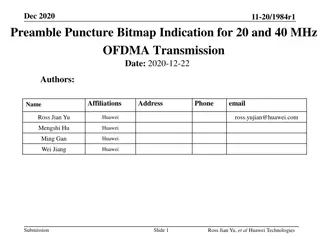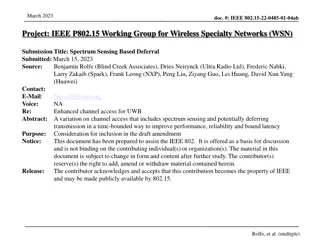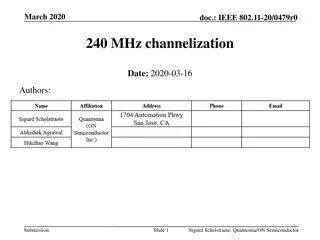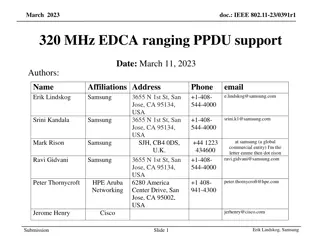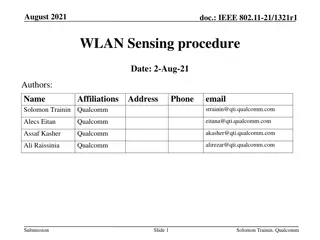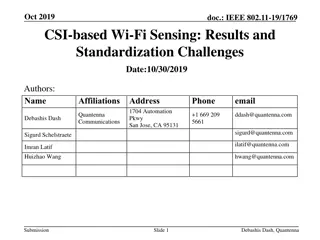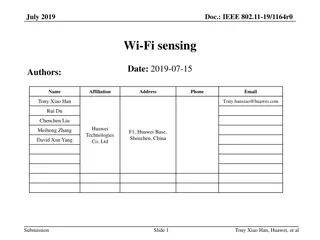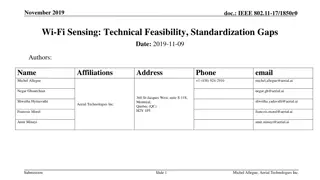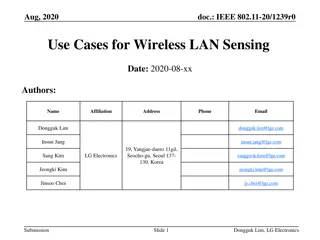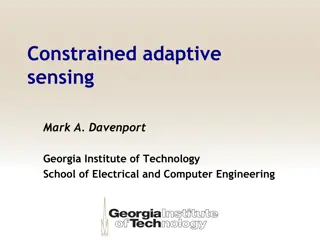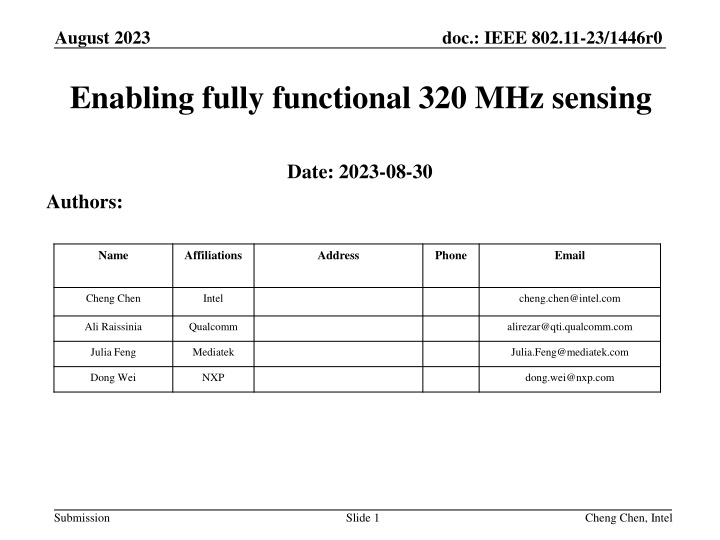
Enabling Fully Functional 320 MHz Sensing in IEEE 802.11-23/1446r0 Proposal
"This technical proposal discusses enabling fully functional 320 MHz sensing for IEEE 802.11bf, addressing necessary changes in D2.0. Current limitations in TB and non-TB sensing measurement exchanges are highlighted, emphasizing the motivation for a complete 320 MHz sensing solution. It reflects the background of existing solutions and the recent developments in the IEEE 802.11 standards. Learn about the alignment of 320 MHz SI2SR/SR2SI/SR2SR NDP with EHT Ranging and TB Ranging NDP for enhanced functionality. Stay updated on the progress towards a comprehensive 320 MHz sensing approach in the IEEE 802.11 framework."
Download Presentation

Please find below an Image/Link to download the presentation.
The content on the website is provided AS IS for your information and personal use only. It may not be sold, licensed, or shared on other websites without obtaining consent from the author. If you encounter any issues during the download, it is possible that the publisher has removed the file from their server.
You are allowed to download the files provided on this website for personal or commercial use, subject to the condition that they are used lawfully. All files are the property of their respective owners.
The content on the website is provided AS IS for your information and personal use only. It may not be sold, licensed, or shared on other websites without obtaining consent from the author.
E N D
Presentation Transcript
doc.: IEEE 802.11-23/1446r0 August 2023 Enabling fully functional 320 MHz sensing Date: 2023-08-30 Authors: Name Affiliations Address Phone Email Cheng Chen Intel cheng.chen@intel.com Ali Raissinia Qualcomm alirezar@qti.qualcomm.com Julia Feng Mediatek Julia.Feng@mediatek.com Dong Wei NXP dong.wei@nxp.com Submission Slide 1 Cheng Chen, Intel
doc.: IEEE 802.11-23/1446r0 August 2023 Executive summary This contribution discusses a technical proposal to enable fully functional 320 MHz sensing for 11bf and the associated changes needed for 11bf D2.0 for this proposal. In LB276, there are a few CIDs related to this topic as well. These CIDs include: CID 3349, 3350, 3351, 3352, 3367. The basic idea is to align the use of 320 MHz SI2SR/SR2SI/SR2SR NDP in 11bf with the 320 MHz EHT Ranging and TB Ranging NDP recently defined in 11bk. Submission Slide 2 Cheng Chen, Intel
doc.: IEEE 802.11-23/1446r0 August 2023 320 MHz sensing in 11bf D2.0 Currently, 320 MHz sensing is only partially supported in 11bf D2.0. TB sensing measurement exchange Only supported in the NDPA sounding phase. Not supported in SR2SI TF sounding phase. Not supported in SR2SR TF sounding phase Non-TB sensing measurement exchange Not supported. Therefore, existing 320 MHz sensing solution in 11bf D2.0 is not a complete one and is not fully functional. Submission Slide 3 Cheng Chen, Intel
doc.: IEEE 802.11-23/1446r0 August 2023 TB and NTB sensing measurement exchange 320 MHz NOT Supported 320 MHz NOT Supported 320 MHz Supported 320 MHz NOT Supported Submission Slide 4 Cheng Chen, Intel
doc.: IEEE 802.11-23/1446r0 August 2023 Background for existing 320 MHz sensing solution The adoption of existing 320 MHz sensing solution was mainly due to restrictions of available options back in D0.1 timeframe. Existing 320 MHz sensing solution was adopted by 11bf with Motion 141 run on Sep. 12, 2022. At that time, the only available 320 MHz NDP is the 320 MHz EHT NDP defined in 11be. Note that 11bf PAR does not allow us to make any PHY changes in sub-7 GHz, so we can only reuse existing NDPs or NDPs defined by other TGs. Because of the strong interest from TGbf members to define 320 MHz sensing, we ended up adopting 320 MHz EHT NDP as the solution. Moreover, given the 320 MHz EHT NDP is only applicable to the DL NDPA sounding phase in TB sensing measurement exchange, 320 MHz sensing is only supported in NDPA sounding phase in TB sensing measurement exchange. Submission Slide 5 Cheng Chen, Intel
doc.: IEEE 802.11-23/1446r0 August 2023 Motivation for enabling fully-functional 320 MHz sensing In Jan. 2023, TGbk (320 MHz Positioning) was formed, and the primary goal for TGbk is to enhance the IEEE 802.11 FTM positioning protocols with the IEEE 802.11be derived 320MHz waveforms1, including defining 320 MHz Ranging and TB Ranging NDP. Most recently, TGbk has generally completed the design of 320 MHz Ranging and TB Ranging NDP in its released D0.2, which is available to all 802.11 members2. 1https://www.ieee802.org/11/Reports/tgbk_update.htm 2https://www.ieee802.org/11/private/Draft_Standards/11bk/index.html Submission Slide 6 Cheng Chen, Intel
doc.: IEEE 802.11-23/1446r0 August 2023 Proposal to enable fully functional 320 MHz sensing With the definition of 320 MHz EHT Ranging and TB Ranging NDP in 11bk, in order to enable fully-functional 320 MHz sensing, we would like to propose the following changes to 11bf D2.0 for the group s consideration. 1. Replace the current 320 MHz EHT NDP used in NDPA sounding phase in TB sensing measurement exchange with the 320 MHz EHT Ranging NDP defined in 11bk. Note: Currently for BW <= 160 MHz, we are already using Ranging NDP in this scenario. 2. Extend the TF sounding phase in TB sensing measurement exchange and Non-TB sensing measurement exchange to 320 MHz with the use of 320 MHz EHT Ranging and TB Ranging NDP defined in 11bk. Note: Again, for BW <= 160 MHz, we are already using Ranging NDP and TB Ranging NDP for these two scenarios. Submission Slide 7 Cheng Chen, Intel
doc.: IEEE 802.11-23/1446r0 August 2023 Benefits of the proposed changes There are a variety of benefits for this proposal: 1. It enables fully functional 320 MHz sensing covering all scenarios in 11bf. In contrast, existing solution only supports 320 MHz sensing in NDPA sounding phase in TB sensing measurement exchange. 2. 320 MHz EHT Ranging NDP brings more flexibilities compared to EHT NDP, such as LTF repetition etc. 3. It fully aligns the use of SI2SR/SR2SI/SR2SR NDP with Ranging/TB Ranging NDP in all TB and NTB flows in 11bf. Note that we are already reusing Ranging NDP in all scenarios with BW <= 160 MHz. Moreover, we are already reusing Ranging NDPA frame and Ranging Trigger frame formats for Sensing NDPA and Sensing Trigger frame formats. 4. It unifies the NDP support for an 11bf device for sub-7 GHz. Currently, an 11bf 320 MHz capable STA needs to support both Ranging NDP (<= 160 MHz) and EHT NDP (320 MHz) for the same protocol flow. It brings additional complexity for the implementation to support two variants of NDP formats. 5. It eases the implementations complexity for existing 11az capable devices to also support 320 MHz sensing. Existing 11az devices can be upgraded to also support 320 MHz EHT Ranging and TB Ranging NDP defined in 11bk. If they are also reused in 11bf, it will significantly reduce the effort for these implementations to also support 320 MHz sensing. Submission Slide 8 Cheng Chen, Intel
doc.: IEEE 802.11-23/1446r0 August 2023 Conclusions In this contribution we presented a proposal to enable fully functional 320 MHz sensing. The basic idea is to align the use of 320 MHz SI2SR/SR2SI/SR2SR NDP in 11bf with the 320 MHz EHT Ranging and TB Ranging NDP recently defined in 11bk. We believe there are multiple benefits for this proposal, and it will greatly help to enhance and promote 320 MHz sensing. Submission Slide 9 Cheng Chen, Intel
doc.: IEEE 802.11-23/1446r0 August 2023 SP Do you agree with the following? 11bf shall adopt the following changes with respect to 320 MHz sensing: 1. Replace the current 320 MHz EHT NDP used in NDPA sounding phase in TB sensing measurement exchange with the 320 MHz EHT Ranging NDP defined in 11bk. 2. Extend the TF sounding phase in TB sensing measurement exchange and Non-TB sensing measurement exchange to 320 MHz with the use of 320 MHz EHT TB Ranging NDP and EHT Ranging NDP defined in 11bk. Submission Slide 10 Cheng Chen, Intel



